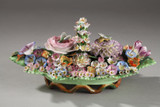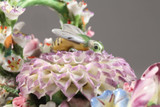A polychrome porcelain inkwell basket, signed Jacob Petit. It is covered with a multitude of flowers in relief: violets, tulips, chrysanthemums, roses, and several varieties of petunias. This piece is highly characteristic of the master's original and whimsical style, with its extraordinary abundance of plants, the contrast of vibrant colors, and the delicate and meticulous rendering of the petals. A rose and a chrysanthemum conceal the two inkwells, surmounted by bees as handles. Marked "JP" in blue under the base. Jacob Mordechai, known as Petit (1796-1865), began by studying painting in Gros's studio, then embarked on numerous journeys to Italy, Switzerland, Germany, and England, where he settled for several years and studied various industries while painting theatrical scenery. Returning to France around 1830, he published a collection of one hundred plates on interior decoration, featuring designs for vases, furniture, and pieces of silverware and joinery, drawing on earlier styles, with a preference for Antiquity and Gothic. After a brief stay in Sèvres, he established a small workshop in Belleville, then acquired the Baruch Weil porcelain factory in Fontainebleau, which he moved a few years later to Avon. This became one of the most celebrated factories of the 1830s-1860s, renowned for its choice of Rococo forms inspired by Saxon porcelain. Highly eclectic, this porcelain maker's style is characterized by the accumulation of elements from earlier styles. These include, either alone or in combination, Troubadour Gothic, Renaissance, Neoclassicism, Rococo, and Far Eastern influences. The flowing forms, vibrant polychromy, and abundance of decorative elements contrast with the sobriety inspired by antiquity. Criticized or admired in their time, Jacob Petit's work gave rise to numerous imitations by various manufacturers. Authentic pieces bear his mark "JP" in blue or impressed. Bibliography: Régine de Plinval de Guillebon, "Jacob Petit, the most romantic of Parisian porcelain makers," L'Estampille/L'Objet d'art, no. 311, March 1997, pp. 48-57. 19th century, circa 1850. Dimensions: L: 26cm, W: 17cm, H: 12cm.
- Reference :
- 1899
- Availability :
- Sold
- Width :
- 26 (cm)
- Height :
- 12 (cm)
- Depth :
- 17 (cm)
- Identify Exists:
- False


























